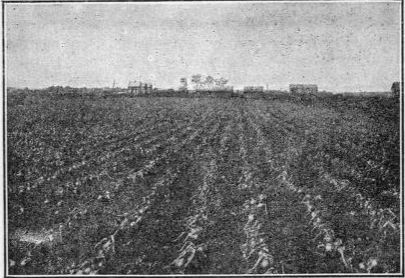540. Harvesting Onion
Description
This section is from the book "Vegetable Gardening", by Ralph L. Watts. Also available from Amazon: Vegetable Gardening.
540. Harvesting Onion
When the bulbs are to be stored they will keep better if allowed to become fully ripe before pulling. Figure 93 illustrates a field of onions in ideal condition for harvesting; the tops are dead and shriveled and the outer skin of the bulbs dry. While full ripeness is highly desirable, other factors should be considered: There is danger of second growth, especially if there is much rain; better prices for the early crop may be an inducement to gather part or all of the crop sooner than if the bulbs are to be stored; when there are large areas to harvest it is necessary to start in ample time in order to complete the work while weather conditions are favorable and before there is loss from rain. Harvesting is often begun when most of the tops have merely turned yellow. Early pulling in the North is especially important for bulbs of foreign types. August and September are the busy harvesting months in the North, and March and April for the Bermuda crop in the South.
It is the universal custom to partially dry or cure the crop in the field. After removing the bulbs by hand or with a plow, if they are covered with soil, 8 or 10 rows of onions are thrown together into windrows, allowed to remain undisturbed for a few days and then stirred occasionally with a wooden rake to facilitate drying. White bulbs are quickly injured by exposure to sun and rain, so that these must be cured under some kind of cover. Topping is usually done in the field after the bulbs are ready for storage, the tops being twisted off by hand or cut with sheep shears. Extensive growers sometimes use topping machines, which also grade and deliver the bulbs in bags or crates. The curing process is continued in sheds, cribs or other suitable houses until the bulbs are ready for permanent storage.

Fig. 93. field of onions at harvest.
Continue to:
Tags
plants, crops, gardening, cultivated, harvesting, food ,greenhouses, fertiliser, vegitables
